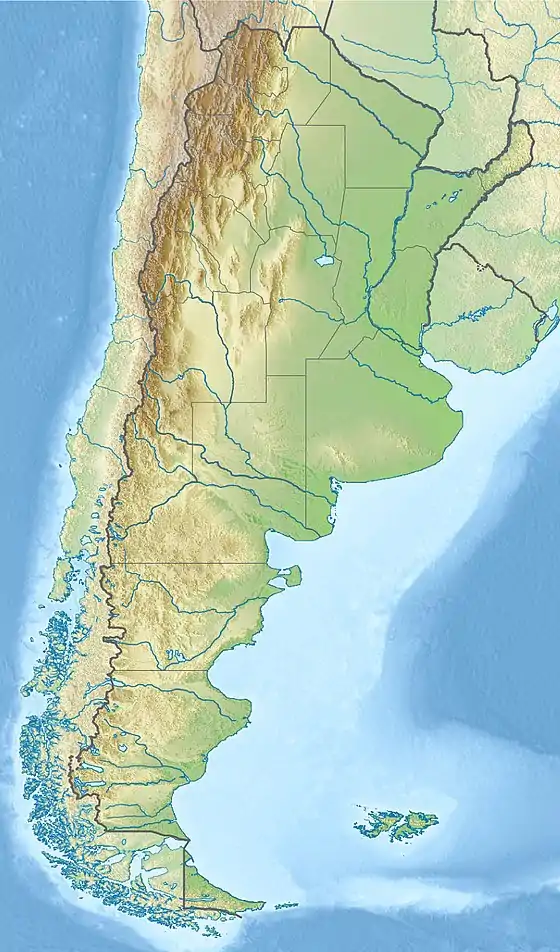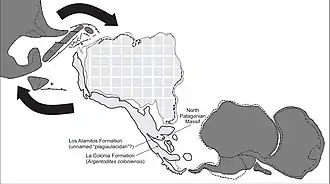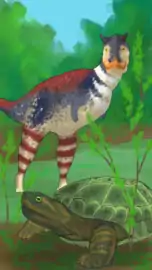La Colonia Formation
The La Colonia Formation is a geological formation in Argentina whose strata date back to the Late Cretaceous. Dinosaur remains are among the fossils that have been recovered from the formation.[1]
| La Colonia Formation Stratigraphic range: Campanian-Maastrichtian ~73–66 Ma | |
|---|---|
| Type | Geological formation |
| Sub-units | Lower, Middle and Upper members |
| Underlies | El Buitre & Sarmiento Formations |
| Overlies | Cerro Barcino & Paso del Sapo Formations |
| Thickness | Up to 210–240 m (690–790 ft) Thinning to 17 m (56 ft) around Telsen |
| Lithology | |
| Primary | Siltstone |
| Other | Sandstone, claystone, conglomerate |
| Location | |
| Coordinates | 43.0°S 67.5°W |
| Approximate paleocoordinates | 45.7°S 53.8°W |
| Region | Chubut Province |
| Country | |
| Extent | Cañadón Asfalto Basin |
| Type section | |
| Named for | Sierra La Colonia |
 La Colonia Formation (Argentina) | |

Originally thought to be Campanian (c.73-72 million years ago) in age or earlier, studies of underlying formations have made a Maastrichtian (70–66 million years ago) age more likely.[2]
It is divided up into three distinct facies, the first is up to 16 metres (52 ft) thick and consists of conglomerate, the second is by far the thickest at over 100 metres (330 ft), consists of siltstone and claystone, with interbeds of claystone/shale and sandstone, the third is less than 10 metres (33 ft) thick and consists of clay, and probably represents a nearshore marine environment.[3]
Flora
The paleoflora was known for its aquatic components, Paleoazolla and Regnellidium.[4] However, recent paleobotanical discoveries at the Cañadón del Irupé locality have revealed the presence of a more diverse range of plants associated with these water bodies, including pteridophytes, gymnosperms, and various angiosperms.[4] Among these are fossil leaves and fruits assignable to Nelumbonaceae.[4]
Fossil content
Turtles
| Turtles from the La Colonia Formation | ||||||
|---|---|---|---|---|---|---|
| Genus | Species | Location | Stratigraphic position | Material | Notes | Images |
| Chelidae gen. nov.[3] | sp. nov. | Norte de Cerro Bayo 2 | Skull and lower jaw; postcranial remains | Represents a new genus of chelid | ||
| Patagoniaemys[3] | P. gasparinae |
|
"skull fragments and several postcranial elements including a nearly complete vertebral column."[5] |  | ||
| aff. Yaminuechelys[3] | Y. gasparinii |
|
"Three specimens formed only by postcranial remains (mainly shell fragments)" | |||
Plesiosaurs
| Plesiosaurs from the La Colonia Formation | ||||||
|---|---|---|---|---|---|---|
| Genus | Species | Location | Stratigraphic position | Material | Notes | Images |
| Elasmosauridae[3] | Indeterminate |
|
"three postcranial specimens that preserve cervical, dorsal and caudal vertebrae, ribs and gastroliths and three vertebrae without collection number" | |||
| Kawanectes[6] | K. lafquenianum | An elasmosaurid | ||||
| Sulcusuchus[3] | S. erraini | Cerro Bosta | "part of skull and mandible" | A polycotylid | ||
Mammals
Over 300 mammal specimens have been found in the La Colonia Formation.[7]
| Mammals of the La Colonia Formation | ||||
|---|---|---|---|---|
| Taxa | Presence | Notes | Images | |
| Argentodites coloniensis | A possible gondwanatherian or multituberculate | |||
| Reigitherium bunodontum | ||||
| Coloniatherium | ||||
Dinosaurs
| Dinosaurs from the La Colonia Formation | ||||||
|---|---|---|---|---|---|---|
| Genus | Species | Location | Stratigraphic position | Material | Notes | Images |
| Abelisauridae[3] | Indeterminate | Norte de Cerro Bayo 1 | "Quite complete and partially articulated skeleton" | Different from Carnotaurus | ||
| Ankylosauria[3] | Indeterminate | Norte de Cerro Bayo 2 | An osteoderm | |||
| Carnotaurus | C. sastrei | Pocho Sastre | "Nearly complete skeleton and skull"[8] | An abelisaurid[9][10] |  | |
| Hadrosauroidea[3] | Indeterminate | Norte de Cerro Bayo 2 | Metatarsal fragment and two vertebral fragments | |||
| Somphospondyli[3] | Indeterminate | Norte de Cerro Bayo 2 | "Two fragmentary caudal vertebrae" | |||
| Theropoda[3] | Indeterminate | Norte de Cerro Bayo 2 | "Metatarsal fragments of a single individual" | |||
See also
- List of dinosaur-bearing rock formations
- Allen Formation, Campanian to Maastrichtian fossiliferous formation of the Neuquén Basin
- Angostura Colorada Formation, Campanian to Maastrichtian fossiliferous formation of the North Patagonian Massif
- Colorado Formation, Campanian to Maastrichtian fossiliferous formation of the Colorado Basin
- Lago Colhué Huapí Formation, Campanian to Maastrichtian fossiliferous formation of the Golfo San Jorge Basin
References
- Weishampel et al., 2004, pp.600-604
- Rauhut, 2003
- Gasparini et al., 2015
- Gandolfo & Cúneo, 2005
- Sterli & De la Fuente, 2011
- O'Gorman, 2019
- Rougier et al., 2009, p.225
- "Table 3.1," in Weishampel et al., 2004, p.49
- Rauhut, 2004
- Leanza et al., 2004, p.72
Bibliography
- Gasparini, Zulma; Juliana Sterli; Ana Parras; José Patricio O'Gorman; Leonardo Salgado; Julio Varela, and Diego Pol. 2015. Late Cretaceous reptilian biota of the La Colonia Formation, central Patagonia, Argentina: Occurrences, preservation and paleoenvironments. Cretaceous Research 54. 154–168. Accessed 2019-04-06. doi:10.1016/j.cretres.2014.11.010ISSN 0195-6671
- Gandolfo, Maria A., and Ruben N. Cúneo. 2005. Fossil Nelumbonaceae from the La Colonia Formation (Campanian–Maastrichtian, Upper Cretaceous), Chubut, Patagonia, Argentina. Review of Palaeobotany and Palynology 133. 170. doi:10.1016/j.revpalbo.2004.09.007ISSN 0034-6667
- O'Gorman, José Patricio. 2019. First record of Kawanectes lafquenianum (Plesiosauria, Elasmosauridae) from the La Colonia Formation of Argentina, with comments on the mandibular morphology of elasmosaurids. Alcheringa: An Australasian Journal of Palaeontology 44. 176–193. doi:10.1080/03115518.2019.1687754
- Leanza, H.A.; S. Apesteguia; F.E. Novas, and M.S. De la Fuente. 2004. Cretaceous terrestrial beds from the Neuquén Basin (Argentina) and their tetrapod assemblages. Cretaceous Research 25. 61–87. Accessed 2019-02-16.
- Rauhut, O.W.M. 2004. Provenance and anatomy of Genyodectes serus, a large-toothed ceratosaur (Dinosauria: Theropoda) from Patagonia. Journal of Vertebrate Paleontology 24. 894–902. Accessed 2019-04-06.
- Rauhut, O.W.M.; G. Cladera; P. Vickers-Rich, and T.H. Rich. 2003. Dinosaur remains from the Lower Cretaceous of the Chubut Group, Argentina. Cretaceous Research 24. 487-497. Accessed 2019-04-06.doi:10.1016/S0195-6671(03)00067-3
- Rougier, G.W.; L. Chornogubsky; S. Casadio; N.P. Arango, and A. Giallombardo. 2009. Mammals from the Allen Formation, Late Cretaceous, Argentina. Cretaceous Research 30. 223–238. Accessed 2019-04-06.
- Sterli, Juliana, and Marcelo S. De la Fuente. 2011. A new turtle from the La Colonia Formation (Campanian–Maastrichtian), Patagonia, Argentina, with remarks on the evolution of the vertebral column in turtles. Palaeontology 54. 63–78. Accessed 2019-04-06.doi:10.1111/j.1475-4983.2010.01002.x
- Weishampel, David B.; Peter Dodson, and Halszka Osmólska (eds.). 2004. The Dinosauria, 2nd edition, 1–880. Berkeley: University of California Press. Accessed 2019-02-21. ISBN 0-520-24209-2
Further reading
- A. M. Albino. 2000. New record of snakes from the Cretaceous of Patagonia (Argentina). Geodiversitas 22(2):247-253
- N. R. Cúneo, E. J. Hermsen, and M. A. Gandolfo. 2013. Regnellidium (Salviniales, Marsileaceae) macrofossils and associated spores from the Late Cretaceous of South America. PloSOne 174(3):340-349
- J. P. O'Gorman, L. Salgado, I. A. Cerda and Z. Gasparini. 2013. First record of gastroliths associated with elasmosaur remains from La Colonia Formation (Campanian–Maastrichtian), Chubut, Patagonia Argentina, with comments on the probable depositional palaeoenvironment of the source of the gastroliths. Cretaceous Research 40:212-217
- J. O'Gorman and Z. Gasparini. 2013. Revision of Sulcusuchus erraini (Sauropterygia, Polycotylidae) from the Upper Cretaceous of Patagonia, Argentina. Alcheringa 37(2):163-176
- T. Harper, A. Parras, and G. W. Rougier. 2018. Reigitherium (Meridiolestida, Mesungulatoidea) an Enigmatic Late Cretaceous Mammal from Patagonia, Argentina: Morphology, Affinities, and Dental Evolution. Journal of Mammalian Evolution
- Z. Kielan-Jaworowska, E. Ortiz-Jaureguizar, C. Vieytes, R. Pascual, and F. J. Goin. 2007. First cimolodontan multituberculate mammal from South America. Acta Palaeontologica Polonica 52(2):257-262